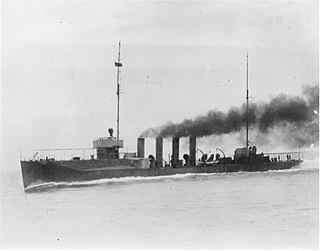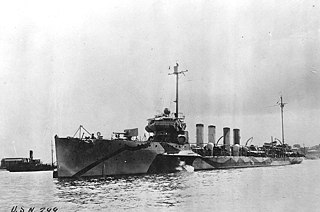
The first USS Cummings (DD-44) was a Cassin-class destroyer used by the United States Navy during World War I. She was later transferred to the United States Coast Guard, where she was designated CG-3. She was named for Lieutenant Commander Andrew Boyd Cummings.

USS Beale (DD-40), a Paulding-class destroyer served in the United States Navy during World War I and later with the United States Coast Guard. She was the first ship of the Navy to be named for Edward Fitzgerald Beale.

USS Drayton (DD-23) was a Paulding-class destroyer in the United States Navy. She was the first ship named for Captain Percival Drayton.

USS Terry (DD-25) was a modified Paulding-class destroyer in the United States Navy during World War I, and later in the United States Coast Guard, designated CG-19. She was the first ship named for Edward A. Terry, and the first ship commanded by future Fleet Admiral and Chief of Naval Operations Ernest J. King.

USS McCall (DD-28) was a Paulding-class destroyer in the United States Navy during World War I and later in the United States Coast Guard, designated CG-14. She was the first ship named for Edward McCall.

USS Burrows (DD-29) was a modified Paulding-class destroyer in the United States Navy during World War I and later in the United States Coast Guard, designated (CG-10). She was the second ship named for Lieutenant William Ward Burrows II.

The first USS Mayrant (DD-31) was a modified Paulding-class destroyer in the United States Navy during World War I. She was named for Captain John Mayrant.

The second USS Trippe (DD-33) was a Paulding-class destroyer in commission in the United States Navy from 1911 to 1919. She was named for Lieutenant John Trippe. She saw service during World War I.

The first USS Ammen (DD-35) was a Paulding-class destroyer in the United States Navy during World War I and later in the United States Coast Guard, designated as CG-8. She was named for Rear Admiral Daniel Ammen.

The first USS Patterson (DD-36) was a modified Paulding-class destroyer in the United States Navy during World War I and later in the United States Coast Guard, designated as CG-16. She was named for Daniel Patterson.
The first USS Jarvis (DD-38) was a modified Paulding-class destroyer in the United States Navy during World War I. She was named for James C. Jarvis.

The first USS Cassin (DD-43) was the lead ship of Cassin-class destroyers in the United States Navy during World War I. She was later transferred to the United States Coast Guard, where she was designated CG-1. She was named for Stephen Cassin.
The first USS Duncan (DD-46) was a Cassin-class destroyer in the United States Navy during World War I. She was named for Commander Silas Duncan.

USS Balch was an Aylwin-class destroyer built for the United States Navy prior to the American entry into World War I. The ship was the first U.S. Navy vessel named in honor of George Beale Balch, a US Navy officer who served in the Mexican–American War and the American Civil War, and as Superintendent of the United States Naval Academy.

USS O'Brien was the lead ship of O'Brien-class destroyers built for the United States Navy prior to the American entry into World War I. The ship was the second US Navy vessel named in honor of Jeremiah O'Brien and his five brothers Gideon, John, William, Dennis, and Joseph who, together on the sloop Unity, captured a British warship during the American Revolutionary War.

USS Winslow was an O'Brien-class destroyer built for the United States Navy prior to the American entry into World War I. The ship was the second US Navy vessel named in honor of John Ancrum Winslow, a US Navy officer notable for sinking the Confederate commerce raider CSS Alabama during the American Civil War.

USS Ericsson was an O'Brien-class destroyer built for the United States Navy prior to the American entry into World War I. The ship was the second U.S. Navy vessel named in honor of John Ericsson, the Swedish-born builder of the ironclad warship USS Monitor during the American Civil War.

USS Tucker was the lead ship of her class of destroyers built for the United States Navy prior to the American entry into World War I. The ship was the first U.S. Navy vessel named for Samuel Tucker.

USS Conyngham was a Tucker-class destroyer built for the United States Navy prior to the American entry into World War I. The ship was the first U.S. Navy vessel named for Gustavus Conyngham.

USS Porter was a Tucker-class destroyer built for the United States Navy prior to the American entry into World War I. The ship was the second U.S. Navy vessel named in honor of both David Porter and his son David Dixon Porter.


















